The female alarmed me by suddenly flying up when I was only a few feet away from the nest. I froze in place and carefully looked around the spot from which she had erupted in flight. Sure enough, I found two eggs on the bare ground next to a small patch of weeds.
The female was very disturbed by my presence. She performed a distraction display about 10 feet away, flopping on the ground as if injured:

The eggs blended with the colors and textures of the surrounding terrain:
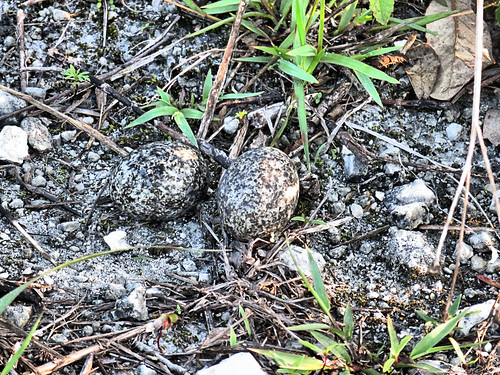
Indeed, I was lucky to find them as they are practically invisible when viewed from any distance. This is about how they looked when I found them. You probably can see them easily here, but if not, look closely at the upper left hand corner of this photo (1/3 down from top and from left edge of frame):
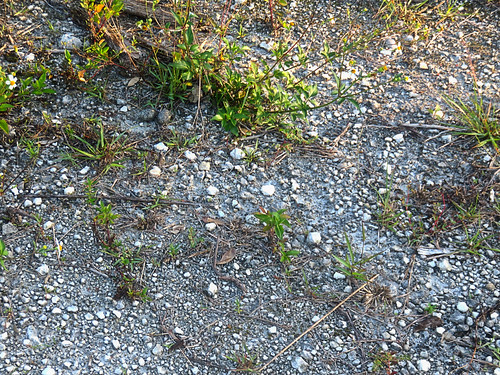
Stepping back, they are very difficult to locate. They are in the lower right quarter of this photo:

This photo shows how vulnerable the nest may be, as people walk their dogs along the path and predators such as Opossums, Raccoons, feral cats and Bobcats all prowl through the area (Arrow points to nest):
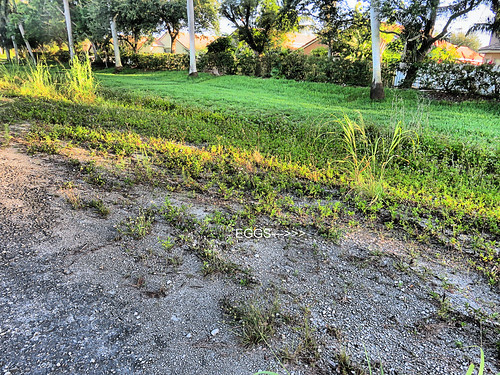
Since then I have photographed the nest every morning from a safe distance with my telescopic lens. Even though I know where to look, the incubating female is almost invisible:


The female sits on the eggs for 16 to 20 days while the male often flies overhead, swooping down and "booming" just over the heads of any passerby. Males have a bright white collar, lacking in the female, and have larger wing spots:


Both members of the pair feed the young, and often the female will start incubating a new batch of eggs while the male continues caring for the first brood.
Killdeers are also nesting along the gravel road. They, too, perform distraction displays to lead intruders away from the nest. Here are examples of one fanning its bright tail and acting as if seriously disabled:
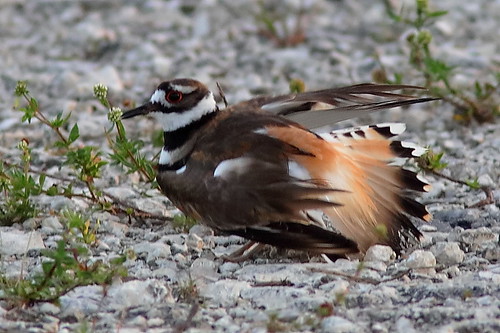

Again, I almost stepped on the Killdeer nest, as it was out in the open. The nest is merely a scrape which is surrounded by a ring of small pebbles which may continued to be added until the eggs hatch. It contained three eggs. The one in the foreground shows the normally darker rounded end which is facing the camera:

Indeed, the next day (May 27) I found another new egg, which I presumed to complete the normal clutch of four for this species. I expected them to soon be rearranged so that all the pointed ends face inward to provide for more efficient incubation:

Surprise! On the morning of May 29 I found yet another egg for a total of five. They must be incubated for 24 to 28 days, exposed to all the hazards which include joy-riding vandals on ATVs:

Out early, the lake provides nice reflections of the clear sky. A clump of Spatterdock (Yellow Pond Lily) floats on the surface:
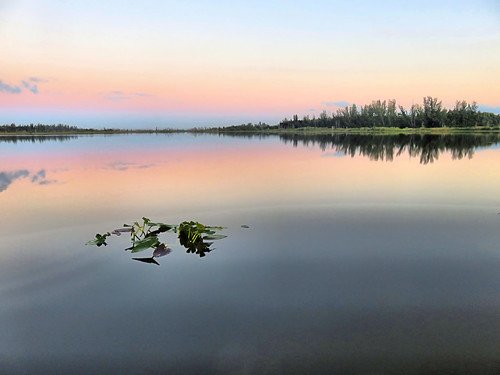
To the south, storm clouds build over the Florida Keys before sunrise:
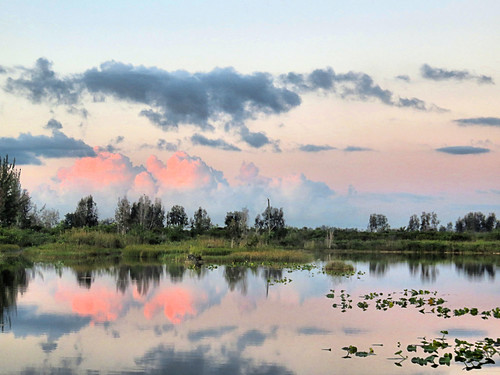
A Tricolored Heron hunts in the predawn twilight:
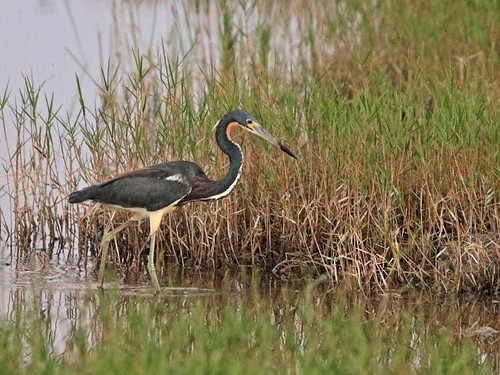
In our back yard, the mangoes are ripening:
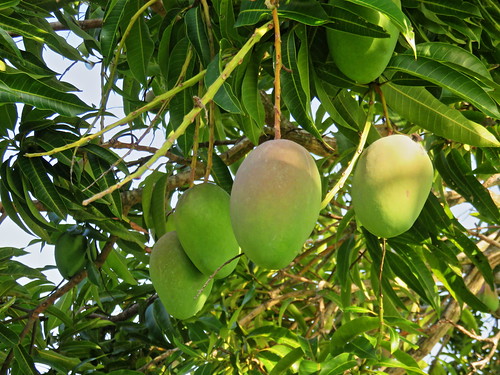
A note about observing nests-- While birds generally will not abandon a nest after brief disturbances, it is best to observe nesting birds from as great a distance as possible. This requires using binoculars or a long lens for photographs. If a bird is flushed from a nest with eggs, it is important to allow the bird to return as soon as possible. As seen in these photos, the disturbance causes great energy-depleting stress for the parent birds. Uncovered eggs are exposed to predation and the effects of extreme temperatures, particularly overheating by the sun which may kill a developing embryo or nestling. Predators also may be attracted to the nest by following your scent or observing your intrusion.
= = = = = = = = = = = = = = =
Linking to Misty's CAMERA CRITTERS,
Linking to Eileen's SATURDAY'S CRITTERS,
Linking to SKYWATCH FRIDAY by Yogi, Sylvia and Sandy
Linking to WEEKEND REFLECTIONS by James
Linking to BirdD'Pot by Anni
Linking to Our World Tuesday by Lady Fi
Linking to Wild Bird Wednesday by Stewart
Linking to Wordless Wednesday (on Tuesday) by NC Sue
Linking to ALL SEASONS by Jesh
________________________________________________
Please visit the links to all these memes to see some excellent photos on display
________________________________________________
aw, you scared it off its eggs :(
ReplyDeleteTheir plumage look very different but very colorful! their eggs remind me of quail eggs :)
ReplyDeleteStunning scenes.
ReplyDeleteI don't know how they have babes hatch by putting the eggs in such a vulnerable place.
ReplyDeleteReflections are fantastic
ReplyDeleteLovely sky and lovely mangoes.
ReplyDeleteExcellent photos. Feel kind of sorry for those birds nesting on the ground. There must by high mortality from all kinds of things. They sure do blend in well!
ReplyDeleteWhat an amazing find and lovely sky.
ReplyDeleteHello, the Nighthawk nest is a great find. I agree about keeping your distance from any kind of nest. I hope no one steps or rides over the eggs. The Nighthawks are cool looking birds, great photos. Your sky photos are lovely, beautiful scene too. Thank you so much for linking up and sharing your post. Happy Saturday, enjoy your day and weekend. PS, thank you for the comment on my blog.
ReplyDeleteHow amazing to be able to get out in nature and see things like this! We are blessed to have so many beautiful birds here in our state! Enjoy your weekend!
ReplyDeleteWhat an interesting documentary and wonderful images! Amazing!
ReplyDeleteMy best regards from Romania!
Beautiful reflections!
ReplyDeleteI've seen lots of fruit trees where I live but no mango trees.
Such an informational post!. I've never seen the nighthawk or the killdeer so thanks for share the pics. So amazing!! The Tricolored Heron is just striking.
ReplyDeleteI so appreciate your additional advise to the disturbance of active nests/nesting. And your photos and knowledge this week are duly noted. Well done, fantastic images.
ReplyDeleteFor linking in with us this weekend at I'd Rather B Birdin', I thank you. Happy birding!
What a great find - makes you wonder how many things we miss.
ReplyDeleteCheers - Stewart M - Melbourne
We don't have the right environs for killdeer where we now live but had a brood of them in the middle of our lawn at our former residence. Such excellent camouflage, and it was fascinating to see the new hatchlings dash off at top speed!
ReplyDeleteThanks for linking up at https://image-in-ing.blogspot.com/2019/06/pop-art-i-dont-get-it.html
Wow what fabulous photos. I hope we get to see some of the chicks in a few weeks time and hopefully they will survive the perils of where they are born. Well done Diane
ReplyDeleteGood luck to the eggs!
ReplyDeleteWow, poor birds can't they nest somewhere else? Actually what you showed cannot e even called a "nest." Never have seen these eggs, looking like rocks! Envious at the mangoes - save me a few:) Many thanks for these interesting details for All Season - have a happy week!
ReplyDeleteVery interesting photos!
ReplyDelete